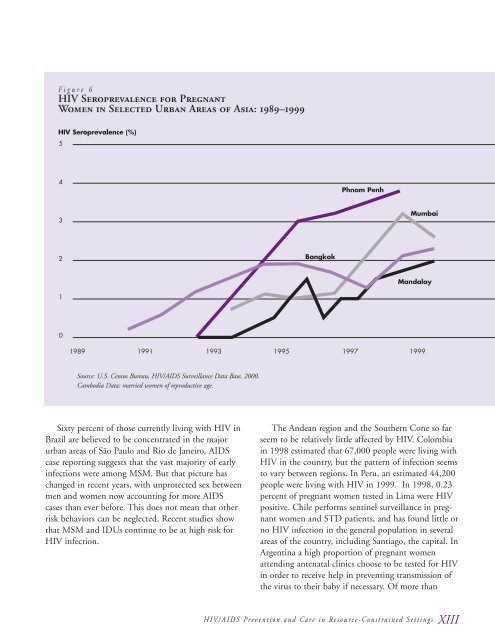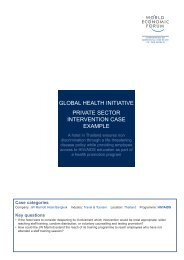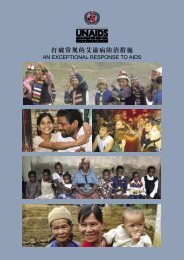X HIV/AIDS Prevention and Care in Resource-Constrained Settings
X HIV/AIDS Prevention and Care in Resource-Constrained Settings
X HIV/AIDS Prevention and Care in Resource-Constrained Settings
- No tags were found...
Create successful ePaper yourself
Turn your PDF publications into a flip-book with our unique Google optimized e-Paper software.
F igure 6<strong>HIV</strong> Seroprevalence for PregnantWomen <strong>in</strong> Selected Urban Areas of Asia: 1989–1999<strong>HIV</strong> Seroprevalence (%)54Phnom Penh3Mumbai2BangkokM<strong>and</strong>alay101989 1991 1993 1995 1997 1999Source: U.S. Census Bureau, <strong>HIV</strong>/<strong>AIDS</strong> Surveillance Data Base, 2000.Cambodia Data: married women of reproductive age.Sixty percent of those currently liv<strong>in</strong>g with <strong>HIV</strong> <strong>in</strong>Brazil are believed to be concentrated <strong>in</strong> the majorurban areas of São Paulo <strong>and</strong> Rio de Janeiro. <strong>AIDS</strong>case report<strong>in</strong>g suggests that the vast majority of early<strong>in</strong>fections were among MSM. But that picture haschanged <strong>in</strong> recent years, with unprotected sex betweenmen <strong>and</strong> women now account<strong>in</strong>g for more <strong>AIDS</strong>cases than ever before. This does not mean that otherrisk behaviors can be neglected. Recent studies showthat MSM <strong>and</strong> IDUs cont<strong>in</strong>ue to be at high risk for<strong>HIV</strong> <strong>in</strong>fection.The Andean region <strong>and</strong> the Southern Cone so farseem to be relatively little affected by <strong>HIV</strong>. Colombia<strong>in</strong> 1998 estimated that 67,000 people were liv<strong>in</strong>g with<strong>HIV</strong> <strong>in</strong> the country, but the pattern of <strong>in</strong>fection seemsto vary between regions. In Peru, an estimated 44,200people were liv<strong>in</strong>g with <strong>HIV</strong> <strong>in</strong> 1999. In 1998, 0.23percent of pregnant women tested <strong>in</strong> Lima were <strong>HIV</strong>positive. Chile performs sent<strong>in</strong>el surveillance <strong>in</strong> pregnantwomen <strong>and</strong> STD patients, <strong>and</strong> has found little orno <strong>HIV</strong> <strong>in</strong>fection <strong>in</strong> the general population <strong>in</strong> severalareas of the country, <strong>in</strong>clud<strong>in</strong>g Santiago, the capital. InArgent<strong>in</strong>a a high proportion of pregnant womenattend<strong>in</strong>g antenatal cl<strong>in</strong>ics choose to be tested for <strong>HIV</strong><strong>in</strong> order to receive help <strong>in</strong> prevent<strong>in</strong>g transmission ofthe virus to their baby if necessary. Of more than<strong>HIV</strong>/<strong>AIDS</strong> <strong>Prevention</strong> <strong>and</strong> <strong>Care</strong> <strong>in</strong> <strong>Resource</strong>-Constra<strong>in</strong>ed Sett<strong>in</strong>gs XIII
















